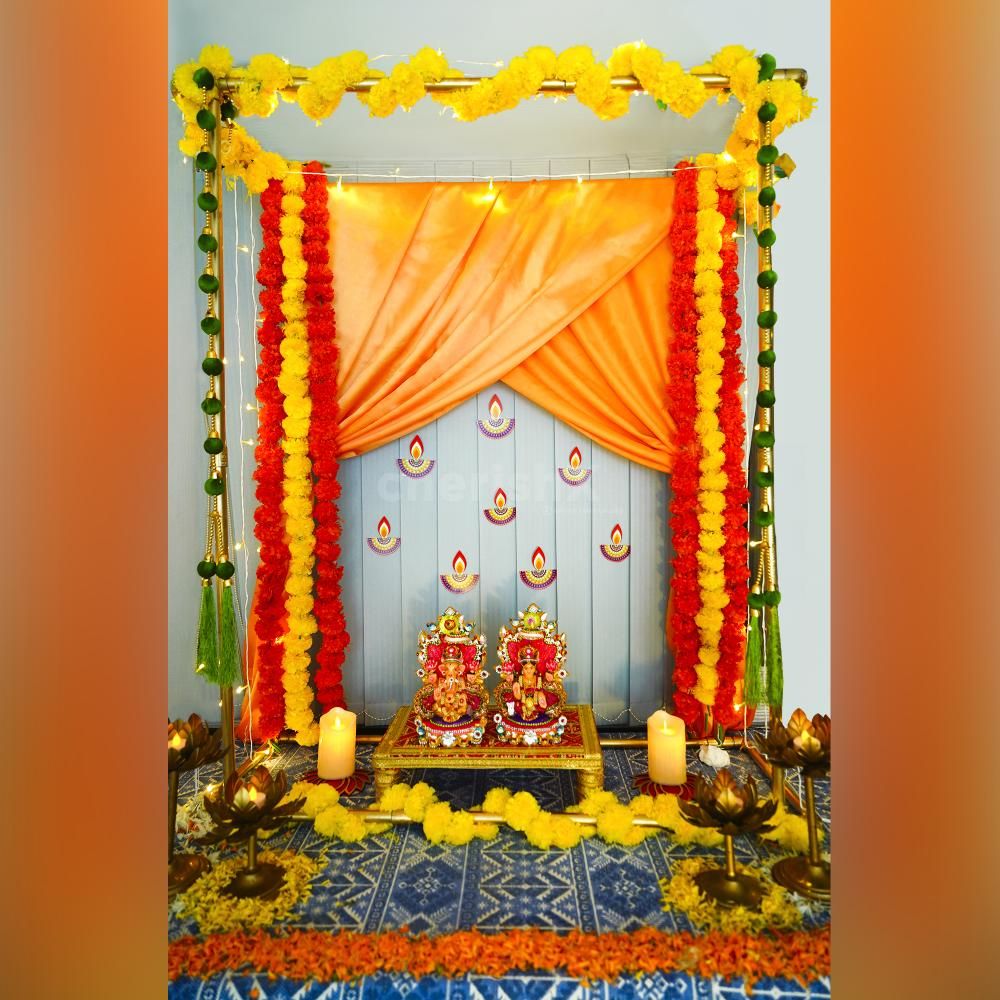Setting up a pooja backdrop at home is a lovely tradition that not only enhances the spiritual ambiance but also adds a touch of elegance to your living space. Over the years, I’ve learned that creating a memorable pooja space involves thoughtful decoration, personal touches, and a bit of creativity. In this comprehensive guide, I will share everything from planning your backdrop to executing the decoration, ensuring that your pooja ceremonies are both beautiful and meaningful.
What is Pooja Backdrop Decoration?
A pooja backdrop decoration is the decorative area behind the altar where prayers are offered. This space is often adorned with fabrics, flowers, lights, and other decorative elements that enhance the overall aesthetic. A well-decorated backdrop sets the tone for the pooja, inviting tranquility and devotion.
Importance of a Well-Designed Backdrop
The backdrop you choose can significantly influence the atmosphere of your pooja. It serves not only as a visual focal point but also as a representation of your faith and devotion. Here are some reasons why a well-designed backdrop is essential:
- Enhances Spiritual Experience: A beautiful backdrop creates a serene environment conducive to prayer and meditation.
- Reflects Personal Style: Your backdrop can be a creative expression of your personality and beliefs.
- Symbolizes Purity: Traditionally, pooja backdrops are designed using clean and pure elements, reflecting the spirit of the rituals.

Planning Your Pooja Backdrop Decoration
Step 1: Choose a Theme

Choosing a theme can streamline your decoration process. Here are some popular themes:
- Traditional: Use rich fabrics, intricate patterns, and traditional symbols.
- Modern: Incorporate minimalist designs, clean lines with subtle elements.
- Nature-Inspired: Use natural materials like wood, flowers, and foliage.

Step 2: Select Your Color Palette
The right color palette can evoke feelings of peace and joy. Some popular color combinations for pooja backdrops include:

| Color Combination | Vibe |
|---|---|
| Gold and White | Elegant and serene |
| Red and Green | Vibrant and festive |
| Blue and Silver | Calm and modern |
| Pastels | Soft and inviting |
Step 3: Gather Materials and Supplies

Here are some essential materials you might need:
- Fabric (cotton, silk, etc.)
- Decorative items (idols, lamps, flowers)
- Lighting (fairy lights, spotlights)
- Adhesives and tools (scissors, glue, tape)
How to Create Your Pooja Backdrop

Step 1: Set the Base
Start by draping your chosen fabric as the base for the backdrop. You can use a single color or mix different fabrics for texture and depth. Consider the height and width available to you!
Step 2: Add Decorative Elements
Now it’s time to layer in decorative elements. Here are some ideas:
- Floral Arrangements: Use fresh or artificial flowers to add vibrancy.
- Lights: Incorporate string lights or candles for a warm glow.
- Artistic Pieces: Include artworks or religious symbols that resonate with you.
Step 3: Position the Altar
Place the altar at the center of the backdrop. Ensure it is accessible and has enough space for worshipping. Surround it with your decorative elements to draw focus.
Tips & Tricks for Effective Decoration
1. Use Layers
Layering different materials creates depth and interest. For instance, you could layer a silk cloth over a cotton one for a luxurious feel.
2. Play with Heights
Varying the height of your decorative items adds dimension. Use stands for flowers or candles to achieve this effect.
3. Incorporate Natural Elements
Natural items like rocks, wood, and plants bring earthy vibes that enhance spirituality.
4. Personal Touches
Incorporate family heirlooms or personal artwork to make the space uniquely yours.
Comparison of Different Backdrop Decoration Styles
| Style | Materials Used | Overall Vibe | Difficulty Level |
|---|---|---|---|
| Traditional | Silk, Jute, Gold | Rich and Regal | Medium |
| Modern | Cotton, Metal, Glass | Sleek and Minimalistic | Easy |
| Nature-Inspired | Wood, Plants, Fabric | Earthy and Calm | Medium |
Pros and Cons of Different Decoration Styles
Traditional Style
Pros:
- Rich in culture and heritage.
- Creates a luxurious ambiance.
Cons:
- Can be expensive to curate.
- May require more maintenance.
Modern Style
Pros:
- Easy to assemble and disassemble.
- Can be budget-friendly.
Cons:
- May lack warmth compared to traditional styles.
- Can feel impersonal if not personalized.
Nature-Inspired Style
Pros:
- Creates a serene and calming space.
- Promotes sustainability.
Cons:
- Natural elements can wilt or decay.
- May require more work to set up.
Frequently Asked Questions (FAQs)
1. What materials are best for a pooja backdrop?
The best materials for a pooja backdrop include cotton, silk, and jute for fabrics, along with decorative elements like flowers and lights.
2. How can I make my backdrop look more luxurious?
Incorporate rich fabrics, golden accents, and layered textures to create an opulent look.
3. Can I use artificial flowers for decoration?
Absolutely! Artificial flowers can look just as beautiful and require less maintenance than fresh flowers.
Conclusion
A thoughtfully designed pooja backdrop not only enhances the spiritual experience but also reflects your personal style and devotion. Whether you opt for a traditional, modern, or nature-inspired theme, the key is to infuse your creativity and spirit into the setup. As you embark on this journey of decoration, remember that the most important aspect is the love and intention behind it. Happy decorating!